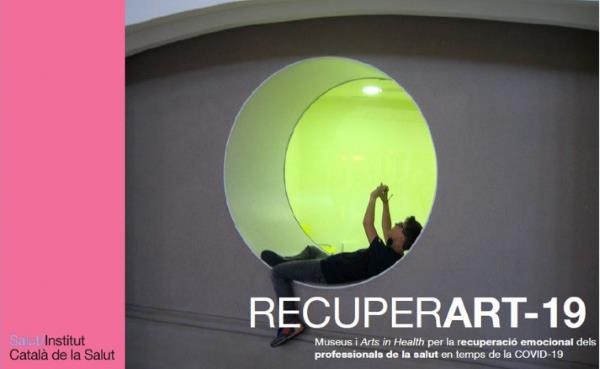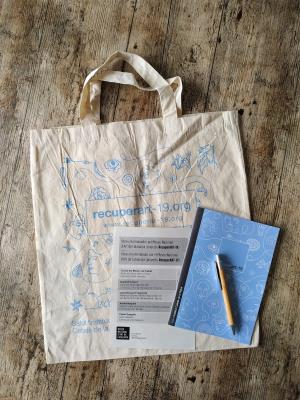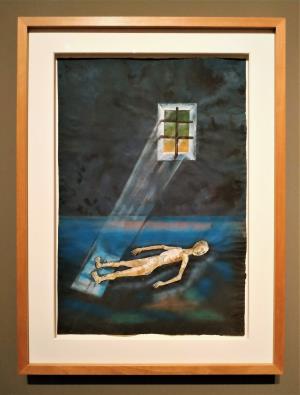Anna Calvet
Can art heal? I am one of those who think so. In it, I have found refuge many times. When I’m discouraged, I like to immerse myself in the silence of museums to look for answers (or find even more questions). Because in a work, I can discover my own reflection. A mirror that gives me back what I project to it. That’s why art is magical. Because it can have as many possible interpretations as there are people in this world.
Just a year ago, and almost by surprise, my life and everyone else’s lives took a 180 degree turn.
Working in a Primary Health-care Centre as a member of a Customer Service team, my work went from being a relatively safe task to being a risky one. And contrary to what people believed, the volume of work grew to unexpected levels. I spent many hours answering calls and listening to terrifying testimonies from people from whom COVID-19 had stolen their loved ones, who they had not even been able to say goodbye to.
Learning to manage the fear of my death or that of the people I love, was one of the hardest things for me at the beginning of the pandemic.
Patients called us anxiously, but I was still a person who was also frightened. Learning to manage the fear of my death or that of the people I love, was one of the hardest things for me at the beginning of the pandemic. However, human beings have a great capacity to adapt and, after a few weeks, I ended up getting used to it, and “normalising” what was happening.
The month of August came and when looking at the Instagram of the MNAC, I discovered the programme ‘RecuperArt-19’. As a lover of art, I said to myself: “That sounds good!”. It was a project for taking care of the emotional health of sanitary professionals. “Look, that’s made for me!” I thought. I proposed to my partner, who also works in Primary Care and we went along in early September.

After climbing the stairs of Montjuïc (half choked by the extra of the mask) we arrived at the Museu Nacional d’Art de Catalunya and asked at reception if we could participate in the programme. They asked us for accreditation as a medical staff and they very kindly explained to us how it worked. They then gave us a cloth bag, inside of which was a notebook and a pen.
The notebook was accompanied by a card with various works from the museum, selected especially for this project. A total of fifteen pieces of different styles and eras. The idea was that we would choose one and that, based on this, we would carry out the activities proposed in the notebook, among which were breathing techniques, drawing, writing, etc.

After entertaining ourselves for a while observing the curious methods of medieval torture embodied in Catalan art, we reached the Modern Art Collection. Beyond the works selected, there I saw one that made me change my first choice. After all, the notebook was no more than a guide that you had to adapt to your emotional needs. It was about feeling free to express ourselves!
I remained staring at the painting for quite a while. How could it reproduce so well what I had felt during the months of lockdown?
I remained staring at the painting for quite a while. How could it reproduce so well what I had felt during the months of lockdown? Art and its great power to explain emotions that we cannot explain in words. The work was entitled The prison, by Joan Ponç, painted in 1950. I was comforted that surely someone had felt the same way I had for so many years.

At that point, the notebook proposed writing a short story. The story that we thought was hidden behind the work we had chosen. Here I share with you what I wrote:
“I don’t know what time it is, but I don’t care anyway. It’s curious that when you spend so many hours with yourself, you end up isolating yourself from those around you. And the hours, the minutes, the time are counted in a different way.
I know it won’t be like this forever. That’s why I’ve learned to be calm. For simple survival. Not to drive me crazy. In these cases, self-control is important.
I look at the window and the little light that enters. A light that looks like a summer’s day to me. I settle for little.
Mmmm… how I would like to eat a good paella…
Desire keeps you alive. It is important not to stop wanting. Because if you lose hope, it’s because you’ve stopped breathing.
The light warms my feet and reminds me of the sheet I pulled over me in the early morning.
It’s curious that being locked in this prison I have found my balance. My peace, my calm.
I don’t want and won’t be here forever.
But even if my body is in captivity, my mind can always fly.
To fly, to kiss, to love, to live. Nothing is forever”
When I finished writing this story, I immediately realised that it was my own story. And that I had been sincere with myself, that I had been able to confess to myself that, thankfully, what had happened during those months had not been entirely bad.
If you, like me, believe in the therapeutic capabilities of art and culture, be sure to visit museums. Now more than ever. Culture heals!
Related links
We take care of mental health in the Museu d’Art de Cerdanyola: Workshop of artistic therapy
Arts and health: challenges and opportunities
Community Manager i Auxiliar Administrativa a l'EAP Sardenya







